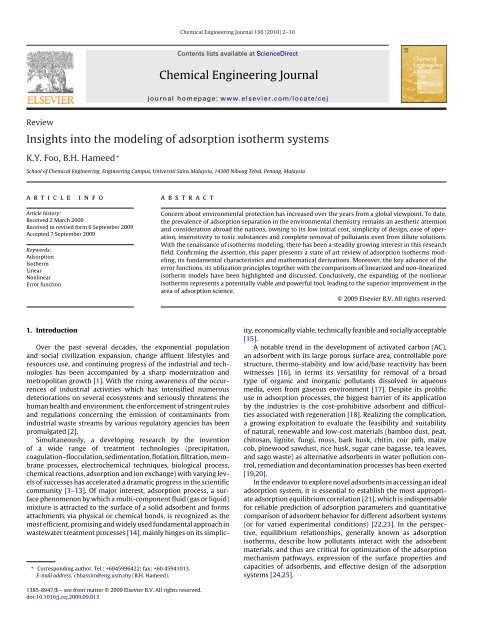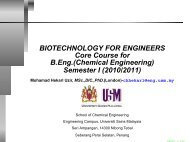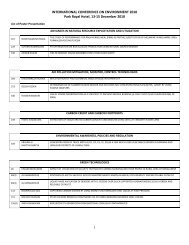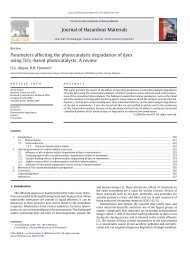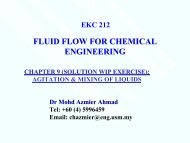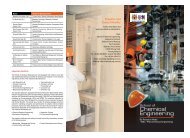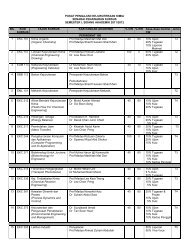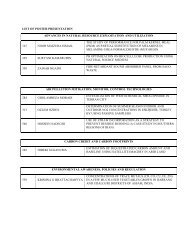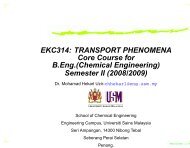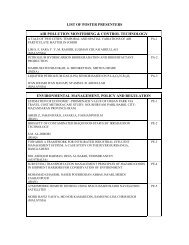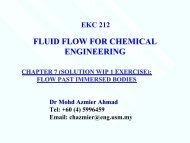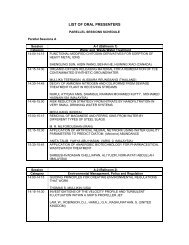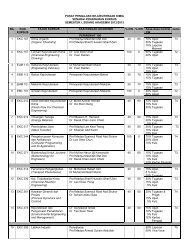Insights into the modeling of adsorption isotherm systems
Insights into the modeling of adsorption isotherm systems
Insights into the modeling of adsorption isotherm systems
Create successful ePaper yourself
Turn your PDF publications into a flip-book with our unique Google optimized e-Paper software.
Review<br />
Chemical Engineering Journal 156 (2010) 2–10<br />
Contents lists available at ScienceDirect<br />
Chemical Engineering Journal<br />
journal homepage: www.elsevier.com/locate/cej<br />
<strong>Insights</strong> <strong>into</strong> <strong>the</strong> <strong>modeling</strong> <strong>of</strong> <strong>adsorption</strong> iso<strong>the</strong>rm <strong>systems</strong><br />
K.Y. Foo, B.H. Hameed ∗<br />
School <strong>of</strong> Chemical Engineering, Engineering Campus, Universiti Sains Malaysia, 14300 Nibong Tebal, Penang, Malaysia<br />
article info<br />
Article history:<br />
Received 2 March 2009<br />
Received in revised form 6 September 2009<br />
Accepted 7 September 2009<br />
Keywords:<br />
Adsorption<br />
Iso<strong>the</strong>rm<br />
Linear<br />
Nonlinear<br />
Error function<br />
1. Introduction<br />
abstract<br />
Over <strong>the</strong> past several decades, <strong>the</strong> exponential population<br />
and social civilization expansion, change affluent lifestyles and<br />
resources use, and continuing progress <strong>of</strong> <strong>the</strong> industrial and technologies<br />
has been accompanied by a sharp modernization and<br />
metropolitan growth [1]. With <strong>the</strong> rising awareness <strong>of</strong> <strong>the</strong> occurrences<br />
<strong>of</strong> industrial activities which has intensified numerous<br />
deteriorations on several eco<strong>systems</strong> and seriously threatens <strong>the</strong><br />
human health and environment, <strong>the</strong> enforcement <strong>of</strong> stringent rules<br />
and regulations concerning <strong>the</strong> emission <strong>of</strong> contaminants from<br />
industrial waste streams by various regulatory agencies has been<br />
promulgated [2].<br />
Simultaneously, a developing research by <strong>the</strong> invention<br />
<strong>of</strong> a wide range <strong>of</strong> treatment technologies (precipitation,<br />
coagulation–flocculation, sedimentation, flotation, filtration, membrane<br />
processes, electrochemical techniques, biological process,<br />
chemical reactions, <strong>adsorption</strong> and ion exchange) with varying levels<br />
<strong>of</strong> successes has accelerated a dramatic progress in <strong>the</strong> scientific<br />
community [3–13]. Of major interest, <strong>adsorption</strong> process, a surface<br />
phenomenon by which a multi-component fluid (gas or liquid)<br />
mixture is attracted to <strong>the</strong> surface <strong>of</strong> a solid adsorbent and forms<br />
attachments via physical or chemical bonds, is recognized as <strong>the</strong><br />
most efficient, promising and widely used fundamental approach in<br />
wastewater treatment processes [14], mainly hinges on its simplic-<br />
∗ Corresponding author. Tel.: +6045996422; fax: +60 45941013.<br />
E-mail address: chbassim@eng.usm.my (B.H. Hameed).<br />
1385-8947/$ – see front matter © 2009 Elsevier B.V. All rights reserved.<br />
doi:10.1016/j.cej.2009.09.013<br />
Concern about environmental protection has increased over <strong>the</strong> years from a global viewpoint. To date,<br />
<strong>the</strong> prevalence <strong>of</strong> <strong>adsorption</strong> separation in <strong>the</strong> environmental chemistry remains an aes<strong>the</strong>tic attention<br />
and consideration abroad <strong>the</strong> nations, owning to its low initial cost, simplicity <strong>of</strong> design, ease <strong>of</strong> operation,<br />
insensitivity to toxic substances and complete removal <strong>of</strong> pollutants even from dilute solutions.<br />
With <strong>the</strong> renaissance <strong>of</strong> iso<strong>the</strong>rms <strong>modeling</strong>, <strong>the</strong>re has been a steadily growing interest in this research<br />
field. Confirming <strong>the</strong> assertion, this paper presents a state <strong>of</strong> art review <strong>of</strong> <strong>adsorption</strong> iso<strong>the</strong>rms <strong>modeling</strong>,<br />
its fundamental characteristics and ma<strong>the</strong>matical derivations. Moreover, <strong>the</strong> key advance <strong>of</strong> <strong>the</strong><br />
error functions, its utilization principles toge<strong>the</strong>r with <strong>the</strong> comparisons <strong>of</strong> linearized and non-linearized<br />
iso<strong>the</strong>rm models have been highlighted and discussed. Conclusively, <strong>the</strong> expanding <strong>of</strong> <strong>the</strong> nonlinear<br />
iso<strong>the</strong>rms represents a potentially viable and powerful tool, leading to <strong>the</strong> superior improvement in <strong>the</strong><br />
area <strong>of</strong> <strong>adsorption</strong> science.<br />
© 2009 Elsevier B.V. All rights reserved.<br />
ity, economically viable, technically feasible and socially acceptable<br />
[15].<br />
A notable trend in <strong>the</strong> development <strong>of</strong> activated carbon (AC),<br />
an adsorbent with its large porous surface area, controllable pore<br />
structure, <strong>the</strong>rmo-stability and low acid/base reactivity has been<br />
witnesses [16], in terms its versatility for removal <strong>of</strong> a broad<br />
type <strong>of</strong> organic and inorganic pollutants dissolved in aqueous<br />
media, even from gaseous environment [17]. Despite its prolific<br />
use in <strong>adsorption</strong> processes, <strong>the</strong> biggest barrier <strong>of</strong> its application<br />
by <strong>the</strong> industries is <strong>the</strong> cost-prohibitive adsorbent and difficulties<br />
associated with regeneration [18]. Realizing <strong>the</strong> complication,<br />
a growing exploitation to evaluate <strong>the</strong> feasibility and suitability<br />
<strong>of</strong> natural, renewable and low-cost materials (bamboo dust, peat,<br />
chitosan, lignite, fungi, moss, bark husk, chitin, coir pith, maize<br />
cob, pinewood sawdust, rice husk, sugar cane bagasse, tea leaves,<br />
and sago waste) as alternative adsorbents in water pollution control,<br />
remediation and decontamination processes has been exerted<br />
[19,20].<br />
In <strong>the</strong> endeavor to explore novel adsorbents in accessing an ideal<br />
<strong>adsorption</strong> system, it is essential to establish <strong>the</strong> most appropriate<br />
<strong>adsorption</strong> equilibrium correlation [21], which is indispensable<br />
for reliable prediction <strong>of</strong> <strong>adsorption</strong> parameters and quantitative<br />
comparison <strong>of</strong> adsorbent behavior for different adsorbent <strong>systems</strong><br />
(or for varied experimental conditions) [22,23]. In <strong>the</strong> perspective,<br />
equilibrium relationships, generally known as <strong>adsorption</strong><br />
iso<strong>the</strong>rms, describe how pollutants interact with <strong>the</strong> adsorbent<br />
materials, and thus are critical for optimization <strong>of</strong> <strong>the</strong> <strong>adsorption</strong><br />
mechanism pathways, expression <strong>of</strong> <strong>the</strong> surface properties and<br />
capacities <strong>of</strong> adsorbents, and effective design <strong>of</strong> <strong>the</strong> <strong>adsorption</strong><br />
<strong>systems</strong> [24,25].
Nomenclature<br />
aK Khan iso<strong>the</strong>rm model exponent<br />
aR Redlich–Peterson iso<strong>the</strong>rm constant (1/mg)<br />
aRP Radke–Prausnitz iso<strong>the</strong>rm model constant<br />
aS Sips iso<strong>the</strong>rm model constant (L/mg)<br />
aT Toth iso<strong>the</strong>rm constant (L/mg)<br />
A Koble–Corrigan iso<strong>the</strong>rm constant (Lnmg1−n /g)<br />
AT Tempkin iso<strong>the</strong>rm equilibrium binding constant<br />
(L/g)<br />
b Langmuir iso<strong>the</strong>rm constant (dm3 /mg)<br />
bK Khan iso<strong>the</strong>rm model constant<br />
bT Tempkin iso<strong>the</strong>rm constant<br />
B Koble–Corrigan iso<strong>the</strong>rm constant (L/mg) n<br />
BDR Dubinin–Radushkevich iso<strong>the</strong>rm constant<br />
Ce equilibrium concentration (mg/L)<br />
Co adsorbate initial concentration (mg/L)<br />
Cs adsorbate<br />
(mg/L)<br />
monolayer saturation concentration<br />
CBET BET <strong>adsorption</strong> iso<strong>the</strong>rm relating to <strong>the</strong> energy <strong>of</strong><br />
surface interaction (L/mg)<br />
d Interlayer spacing (m)<br />
ε Dubinin–Radushkevich iso<strong>the</strong>rm constant<br />
E mean free energy (kJ/mol)<br />
g Redlich–<br />
Peterson iso<strong>the</strong>rm exponent<br />
�G◦ Gibbs energy change (kJ/mol)<br />
k MacMillan–Teller (MET) iso<strong>the</strong>rm constant<br />
Kad Dubinin–Radushkevich<br />
(mol<br />
iso<strong>the</strong>rm constant<br />
2 /kJ2 )<br />
KD Hill constant<br />
KF Freundlich iso<strong>the</strong>rm constant (mg/g) (dm3 /g) n<br />
KFH<br />
related to <strong>adsorption</strong> capacity<br />
Flory–Huggins iso<strong>the</strong>rm equilibrium constant (L/g)<br />
KL Langmuir iso<strong>the</strong>rm constant (L/mg)<br />
KR Redlich–Peterson iso<strong>the</strong>rm constant (L/g)<br />
Ks Sips iso<strong>the</strong>rm model constant (L/g)<br />
KT Toth iso<strong>the</strong>rm constant (mg/g)<br />
n <strong>adsorption</strong> intensity<br />
nFH Flory–Huggins iso<strong>the</strong>rm model exponent<br />
nH Hill cooperativity coefficient <strong>of</strong> <strong>the</strong> binding interaction<br />
p number <strong>of</strong> parameter<br />
qe amount <strong>of</strong> adsorbate in <strong>the</strong> adsorbent at equilibrium<br />
(mg/g)<br />
qe,calc calculated adsorbate concentration at equilibrium<br />
(mg/g)<br />
qe,meas measured adsorbate concentration at equilibrium<br />
(mg/g)<br />
qs <strong>the</strong>oretical iso<strong>the</strong>rm saturation capacity (mg/g)<br />
qsH Hill iso<strong>the</strong>rm maximum uptake saturation (mg/L)<br />
Qo maximum monolayer coverage capacities (mg/g)<br />
r inverse power <strong>of</strong> distance from <strong>the</strong> surface<br />
rR Radke–Prausnitz iso<strong>the</strong>rm model constant<br />
R universal gas constant (8.314 J/mol K)<br />
R2 correlation coefficient<br />
RL separation factor<br />
t Toth iso<strong>the</strong>rm constant<br />
T temperature (K)<br />
degree <strong>of</strong> surface coverage<br />
˛ Frenkel–Halsey–Hill iso<strong>the</strong>rm constant (J mr /mole)<br />
with r is <strong>the</strong> sign <strong>of</strong> inverse power <strong>of</strong> distance from<br />
<strong>the</strong> surface<br />
ˇR Radke–Prausnitz iso<strong>the</strong>rm model exponent<br />
ˇS Sips iso<strong>the</strong>rm model exponent<br />
K.Y. Foo, B.H. Hameed / Chemical Engineering Journal 156 (2010) 2–10 3<br />
Meanwhile, linear least-squares method is a traditional linearly<br />
transformed approach widely adopted to determine <strong>the</strong> iso<strong>the</strong>rm<br />
parameters or <strong>the</strong> most fitted model, primarily subjected to its<br />
goodness fit to <strong>the</strong> experimental data, with <strong>the</strong> magnitude regression<br />
correlation coefficients that close to unity [26]. Never<strong>the</strong>less, a<br />
substantial constriction related to <strong>the</strong> linearized iso<strong>the</strong>rm expressions<br />
has recently been pointed out, which produce a vast amount<br />
<strong>of</strong> different outcomes, implicitly alter <strong>the</strong> error structure, violate<br />
<strong>the</strong> error variance and normality assumptions <strong>of</strong> standard least<br />
squares, leading to <strong>the</strong> bias <strong>of</strong> <strong>the</strong> <strong>adsorption</strong> data [27,28]. Depending<br />
on <strong>the</strong> way <strong>the</strong> adsorptive equation is linearized, <strong>the</strong> error<br />
distribution changes worse. This has attested <strong>the</strong> utilization <strong>of</strong> nonlinearized<br />
models in conjunction with a number <strong>of</strong> error analysis<br />
techniques [29–31]. With <strong>the</strong> aforementioned, this bibliographic<br />
review attempts to postulate a platform in describing <strong>the</strong> distinct<br />
properties, development and potential applications <strong>of</strong> <strong>adsorption</strong><br />
iso<strong>the</strong>rm <strong>systems</strong>. The present work is aimed at evaluating <strong>the</strong>ir<br />
accuracy and consistency in parameters prediction or estimation.<br />
The extent <strong>of</strong> <strong>the</strong> error functions toge<strong>the</strong>r with its comprehensive<br />
literature comparisons has been highlighted and outlined, to<br />
familiarize <strong>the</strong> knowledge deficiencies regarding non-linearized<br />
<strong>adsorption</strong> iso<strong>the</strong>rms.<br />
2. Adsorption iso<strong>the</strong>rms models<br />
In general, an <strong>adsorption</strong> iso<strong>the</strong>rm is an invaluable curve<br />
describing <strong>the</strong> phenomenon governing <strong>the</strong> retention (or release)<br />
or mobility <strong>of</strong> a substance from <strong>the</strong> aqueous porous media or<br />
aquatic environments to a solid-phase at a constant temperature<br />
and pH [32,33]. Adsorption equilibrium (<strong>the</strong> ratio between <strong>the</strong><br />
adsorbed amount with <strong>the</strong> remaining in <strong>the</strong> solution) is established<br />
when an adsorbate containing phase has been contacted with <strong>the</strong><br />
adsorbent for sufficient time, with its adsorbate concentration in<br />
<strong>the</strong> bulk solution is in a dynamic balance with <strong>the</strong> interface concentration<br />
[30,34]. Typically, <strong>the</strong> ma<strong>the</strong>matical correlation, which<br />
constitutes an important role towards <strong>the</strong> <strong>modeling</strong> analysis, operational<br />
design and applicable practice <strong>of</strong> <strong>the</strong> <strong>adsorption</strong> <strong>systems</strong>, is<br />
usually depicted by graphically expressing <strong>the</strong> solid-phase against<br />
its residual concentration [35].<br />
Its physicochemical parameters toge<strong>the</strong>r with <strong>the</strong> underlying<br />
<strong>the</strong>rmodynamic assumptions provide an insight <strong>into</strong> <strong>the</strong> <strong>adsorption</strong><br />
mechanism, surface properties as well as <strong>the</strong> degree <strong>of</strong> affinity<br />
<strong>of</strong> <strong>the</strong> adsorbents [36].<br />
Over <strong>the</strong> years, a wide variety <strong>of</strong> equilibrium iso<strong>the</strong>rm models<br />
(Langmuir, Freundlich, Brunauer–Emmett–Teller, Redlich–<br />
Peterson, Dubinin–Radushkevich, Temkin, Toth, Koble–Corrigan,<br />
Sips, Khan, Hill, Flory–Huggins and Radke–Prausnitz iso<strong>the</strong>rm),<br />
have been formulated in terms <strong>of</strong> three fundamental approaches<br />
[37]. Kinetic consideration is <strong>the</strong> first approach to be referred.<br />
Hereby, <strong>adsorption</strong> equilibrium is defined being a state <strong>of</strong> dynamic<br />
equilibrium, with both <strong>adsorption</strong> and desorption rates are equal<br />
[38]. Whereas, <strong>the</strong>rmodynamics, being a base <strong>of</strong> <strong>the</strong> second<br />
approach, can provide a framework <strong>of</strong> deriving numerous forms<br />
<strong>of</strong> <strong>adsorption</strong> iso<strong>the</strong>rm models [39,40], and potential <strong>the</strong>ory, as <strong>the</strong><br />
third approach, usually conveys <strong>the</strong> main idea in <strong>the</strong> generation<br />
<strong>of</strong> characteristic curve [41]. However, an interesting trend in <strong>the</strong><br />
iso<strong>the</strong>rm <strong>modeling</strong> is <strong>the</strong> derivation in more than one approach,<br />
thus directing to <strong>the</strong> difference in <strong>the</strong> physical interpretation <strong>of</strong> <strong>the</strong><br />
model parameters [42].<br />
2.1. Two parameter iso<strong>the</strong>rms<br />
2.1.1. Langmuir iso<strong>the</strong>rm model<br />
Langmuir <strong>adsorption</strong> iso<strong>the</strong>rm, originally developed to describe<br />
gas–solid-phase <strong>adsorption</strong> onto activated carbon, has traditionally
4 K.Y. Foo, B.H. Hameed / Chemical Engineering Journal 156 (2010) 2–10<br />
been used to quantify and contrast <strong>the</strong> performance <strong>of</strong> different<br />
bio-sorbents [38]. In its formulation, this empirical model assumes<br />
monolayer <strong>adsorption</strong> (<strong>the</strong> adsorbed layer is one molecule in thickness),<br />
with <strong>adsorption</strong> can only occur at a finite (fixed) number<br />
<strong>of</strong> definite localized sites, that are identical and equivalent, with<br />
no lateral interaction and steric hindrance between <strong>the</strong> adsorbed<br />
molecules, even on adjacent sites [43]. In its derivation, Langmuir<br />
iso<strong>the</strong>rm refers to homogeneous <strong>adsorption</strong>, which each molecule<br />
possess constant enthalpies and sorption activation energy (all sites<br />
possess equal affinity for <strong>the</strong> adsorbate) [44], with no transmigration<br />
<strong>of</strong> <strong>the</strong> adsorbate in <strong>the</strong> plane <strong>of</strong> <strong>the</strong> surface [45].<br />
Graphically, it is characterized by a plateau, an equilibrium saturation<br />
point where once a molecule occupies a site, no fur<strong>the</strong>r<br />
<strong>adsorption</strong> can take place [33,46]. Moreover, Langmuir <strong>the</strong>ory has<br />
related rapid decrease <strong>of</strong> <strong>the</strong> intermolecular attractive forces to <strong>the</strong><br />
rise <strong>of</strong> distance. The ma<strong>the</strong>matical expression <strong>of</strong> Langmuir iso<strong>the</strong>rm<br />
models are illustrated in Table 1. Hereby, a dimensionless constant,<br />
commonly known as separation factor (RL) defined by Webber and<br />
Chakkravorti [47] can be represented as:<br />
1<br />
RL =<br />
(1)<br />
1 + KLCo<br />
where KL (L/mg) refers to <strong>the</strong> Langmuir constant and Co is denoted<br />
to <strong>the</strong> adsorbate initial concentration (mg/L). In this context, lower<br />
RL value reflects that <strong>adsorption</strong> is more favourable. In a deeper<br />
explanation, RL value indicates <strong>the</strong> <strong>adsorption</strong> nature to be ei<strong>the</strong>r<br />
unfavourable (RL > 1), linear (RL = 1), favourable (0 < RL < 1) or irreversible<br />
(RL = 0).<br />
2.1.2. Freundlich iso<strong>the</strong>rm model<br />
Freundlich iso<strong>the</strong>rm [48] is <strong>the</strong> earliest known relationship<br />
describing <strong>the</strong> non-ideal and reversible <strong>adsorption</strong>, not restricted to<br />
<strong>the</strong> formation <strong>of</strong> monolayer. This empirical model can be applied to<br />
multilayer <strong>adsorption</strong>, with non-uniform distribution <strong>of</strong> <strong>adsorption</strong><br />
heat and affinities over <strong>the</strong> heterogeneous surface [49]. Historically,<br />
it is developed for <strong>the</strong> <strong>adsorption</strong> <strong>of</strong> animal charcoal, demonstrating<br />
that <strong>the</strong> ratio <strong>of</strong> <strong>the</strong> adsorbate onto a given mass <strong>of</strong> adsorbent to<br />
<strong>the</strong> solute was not a constant at different solution concentrations<br />
[19]. In this perspective, <strong>the</strong> amount adsorbed is <strong>the</strong> summation <strong>of</strong><br />
<strong>adsorption</strong> on all sites (each having bond energy), with <strong>the</strong> stronger<br />
binding sites are occupied first, until <strong>adsorption</strong> energy are exponentially<br />
decreased upon <strong>the</strong> completion <strong>of</strong> <strong>adsorption</strong> process<br />
[50].<br />
At present, Freundlich iso<strong>the</strong>rm is widely applied in heterogeneous<br />
<strong>systems</strong> especially for organic compounds or highly<br />
interactive species on activated carbon and molecular sieves. The<br />
slope ranges between 0 and 1 is a measure <strong>of</strong> <strong>adsorption</strong> intensity<br />
or surface heterogeneity, becoming more heterogeneous as its<br />
value gets closer to zero. Whereas, a value below unity implies<br />
chemisorptions process where 1/n above one is an indicative <strong>of</strong><br />
cooperative <strong>adsorption</strong> [51]. Its linearized and non-linearized equations<br />
are listed in Table 1. Recently, Freundlich iso<strong>the</strong>rm is criticized<br />
for its limitation <strong>of</strong> lacking a fundamental <strong>the</strong>rmodynamic basis,<br />
not approaching <strong>the</strong> Henry’s law at vanishing concentrations [23].<br />
2.1.3. Dubinin–Radushkevich iso<strong>the</strong>rm model<br />
Dubinin–Radushkevich iso<strong>the</strong>rm [52], is an empirical model<br />
initially conceived for <strong>the</strong> <strong>adsorption</strong> <strong>of</strong> subcritical vapors onto<br />
micropore solids following a pore filling mechanism. It is generally<br />
applied to express <strong>the</strong> <strong>adsorption</strong> mechanism [53] with a Gaussian<br />
energy distribution onto a heterogeneous surface [54]. The<br />
model has <strong>of</strong>ten successfully fitted high solute activities and <strong>the</strong><br />
intermediate range <strong>of</strong> concentrations data well, but has unsatisfactory<br />
asymptotic properties and does not predict <strong>the</strong> Henry’s law<br />
at low pressure [55]. The approach was usually applied to distinguish<br />
<strong>the</strong> physical and chemical <strong>adsorption</strong> <strong>of</strong> metal ions [41], with<br />
its mean free energy, E per molecule <strong>of</strong> adsorbate (for removing a<br />
molecule from its location in <strong>the</strong> sorption space to <strong>the</strong> infinity) can<br />
be computed by <strong>the</strong> relationship [56]:<br />
� �<br />
1<br />
E = � (2)<br />
2BDR<br />
where BDR is denoted as <strong>the</strong> iso<strong>the</strong>rm constant. Meanwhile, <strong>the</strong><br />
parameter ε can be correlated as:<br />
�<br />
ε = RT ln 1 + 1<br />
�<br />
(3)<br />
Ce<br />
where R, T and Ce represent <strong>the</strong> gas constant (8.314 J/mol K),<br />
absolute temperature (K) and adsorbate equilibrium concentration<br />
(mg/L), respectively. One <strong>of</strong> <strong>the</strong> unique features <strong>of</strong> <strong>the</strong><br />
Dubinin–Radushkevich iso<strong>the</strong>rm model lies on <strong>the</strong> fact that it is<br />
temperature-dependent, which when <strong>adsorption</strong> data at different<br />
temperatures are plotted as a function <strong>of</strong> logarithm <strong>of</strong> amount<br />
adsorbed vs <strong>the</strong> square <strong>of</strong> potential energy, all suitable data will<br />
lie on <strong>the</strong> same curve, named as <strong>the</strong> characteristic curve.<br />
2.1.4. Temkin iso<strong>the</strong>rm model<br />
Temkin iso<strong>the</strong>rm is <strong>the</strong> early model describing <strong>the</strong> <strong>adsorption</strong><br />
<strong>of</strong> hydrogen onto platinum electrodes within <strong>the</strong> acidic solutions.<br />
The iso<strong>the</strong>rm [57] contains a factor that explicitly taking<br />
<strong>into</strong> <strong>the</strong> account <strong>of</strong> adsorbent–adsorbate interactions. By ignoring<br />
<strong>the</strong> extremely low and large value <strong>of</strong> concentrations, <strong>the</strong> model<br />
assumes that heat <strong>of</strong> <strong>adsorption</strong> (function <strong>of</strong> temperature) <strong>of</strong> all<br />
molecules in <strong>the</strong> layer would decrease linearly ra<strong>the</strong>r than logarithmic<br />
with coverage [58]. As implied in <strong>the</strong> equation, its derivation<br />
is characterized by a uniform distribution <strong>of</strong> binding energies (up<br />
to some maximum binding energy). Temkin equation is excellent<br />
for predicting <strong>the</strong> gas phase equilibrium (when organization<br />
in a tightly packed structure with identical orientation is not<br />
necessary), conversely complex <strong>adsorption</strong> <strong>systems</strong> including <strong>the</strong><br />
liquid-phase <strong>adsorption</strong> iso<strong>the</strong>rms are usually not appropriate to<br />
be represented [59].<br />
2.1.5. Flory–Huggins iso<strong>the</strong>rm model<br />
Flory–Huggins iso<strong>the</strong>rm model [60], which occasionally deriving<br />
<strong>the</strong> degree <strong>of</strong> surface coverage characteristics <strong>of</strong> adsorbate onto<br />
adsorbent, can express <strong>the</strong> feasibility and spontaneous nature <strong>of</strong><br />
an <strong>adsorption</strong> process. In this respect, is <strong>the</strong> degree <strong>of</strong> surface<br />
coverage, where KFH and nFH are <strong>the</strong> indication <strong>of</strong> its equilibrium<br />
constant and model exponent. Its equilibrium constant, KFH that<br />
used for <strong>the</strong> calculation <strong>of</strong> spontaneity free Gibbs energy, is related<br />
to <strong>the</strong> equation [43]:<br />
�G ◦ =−RT ln (KFH) (4)<br />
2.1.6. Hill iso<strong>the</strong>rm model<br />
Hill equation [61], that originated from <strong>the</strong> NICA [62] model,<br />
was postulated to describe <strong>the</strong> binding <strong>of</strong> different species onto<br />
homogeneous substrates. The model assumes that <strong>adsorption</strong> is a<br />
cooperative phenomenon, with <strong>the</strong> ligand binding ability at one<br />
site on <strong>the</strong> macromolecule, may influence different binding sites<br />
on <strong>the</strong> same macromolecule [63].<br />
2.2. Three parameter iso<strong>the</strong>rms<br />
2.2.1. Redlich–Peterson iso<strong>the</strong>rm model<br />
Redlich–Peterson iso<strong>the</strong>rm [64] is a hybrid iso<strong>the</strong>rm featuring<br />
both Langmuir and Freundlich iso<strong>the</strong>rms, which incorporate three<br />
parameters <strong>into</strong> an empirical equation [65]. The model has a linear<br />
dependence on concentration in <strong>the</strong> numerator and an exponential<br />
function in <strong>the</strong> denominator [66] to represent <strong>adsorption</strong> equilibria<br />
over a wide concentration range, that can be applied ei<strong>the</strong>r
Table 1<br />
Lists <strong>of</strong> <strong>adsorption</strong> iso<strong>the</strong>rms models.<br />
K.Y. Foo, B.H. Hameed / Chemical Engineering Journal 156 (2010) 2–10 5<br />
Iso<strong>the</strong>rm Nonlinear form Linear form Plot Reference<br />
Langmuir qe = QobCe<br />
1+bCe<br />
Freundlich qe = KF C 1/n<br />
e<br />
Ce 1 Ce<br />
= + qe bQo Qo<br />
1 1 1<br />
= + qe Qo bQoCe<br />
qe = Qo − qe<br />
bCe<br />
qe = bQo − bqe<br />
Ce<br />
Ce<br />
qe<br />
1<br />
qe<br />
vs Ce [38]<br />
vs 1<br />
Ce<br />
qe vs qe<br />
bCe<br />
qe<br />
Ce<br />
vs qe<br />
log qe = log KF + 1<br />
log Ce log qe vs log Ce [48]<br />
n<br />
Dubinin–Radushkevich qe =(qs) exp(−kadε2 ) ln(qe)=ln(qs) − kadε2 In(qe) vsε2 [52]<br />
Tempkin qe = RT<br />
ln AT Ce bT qe = RT<br />
Flory–Huggins Co<br />
� �<br />
RT<br />
ln AT + ln Ce<br />
bT bT qe vs ln Ce [57]<br />
= KFH(1 − )n FH<br />
�<br />
log = log (KFH) + nFH log (1 − )<br />
�<br />
log vs log(1 − ) [60]<br />
Hill qe = qs H CnH e<br />
KD +CnH e<br />
Redlich–Peterson qe = K R Ce<br />
1+a R C g<br />
e<br />
Sips qe = KsCˇS e<br />
1+aS CˇS e<br />
Toth qe = KT Ce<br />
(aT +Ce) 1/t<br />
Koble–Corrigan qe = ACn e<br />
1+BC n e<br />
log<br />
ln<br />
� Co<br />
� � � �<br />
qe<br />
qe<br />
= nH log (Ce) − log (KD) log<br />
vs log(Ce) [61]<br />
qs −qe<br />
qs −qe<br />
H H<br />
�<br />
Ce<br />
KR − 1 qe<br />
ˇS ln(Ce) =−ln<br />
ln<br />
� qe<br />
K T<br />
� = g ln(Ce) + ln(aR) ln<br />
� �<br />
Ks<br />
+ ln(aS) ln<br />
qe<br />
� Co<br />
�<br />
Ce<br />
KR − 1 qe<br />
� Ks<br />
qe<br />
� �<br />
1<br />
qe<br />
= ln(Ce) − ln(aT + Ce) ln<br />
t KT � vs ln(Ce) [64]<br />
� vs ln(Ce) [68]<br />
� vs ln(Ce) [69]<br />
1 1<br />
= qe ACn +<br />
e<br />
B<br />
– [70]<br />
A<br />
Khan qe = qsb K Ce<br />
(1+b K Ce) a K – – [71]<br />
Radke–Prausnitz qe = aRP rRCˇR e<br />
aRP +rRC ˇR −1<br />
e<br />
BET qe =<br />
FHH ln<br />
qsC BET Ce<br />
(Cs−Ce)[1+(C BET −1)(Ce/Cs)]<br />
� Ce<br />
Cs<br />
MET qe = qs<br />
� =− ˛<br />
RT<br />
�<br />
� qs<br />
qed<br />
�1/3 k<br />
ln(Cs/Ce)<br />
in homogeneous or heterogeneous <strong>systems</strong> due to its versatility<br />
[22]. Typically, a minimization procedure is adopted in solving <strong>the</strong><br />
equations by maximizing <strong>the</strong> correlation coefficient between <strong>the</strong><br />
experimental data points and <strong>the</strong>oretical model predictions with<br />
solver add-in function <strong>of</strong> <strong>the</strong> Micros<strong>of</strong>t excel [26]. In <strong>the</strong> limit, it<br />
approaches Freundlich iso<strong>the</strong>rm model at high concentration (as<br />
<strong>the</strong> exponent ˇ tends to zero) and is in accordance with <strong>the</strong> low<br />
concentration limit <strong>of</strong> <strong>the</strong> ideal Langmuir condition (as <strong>the</strong> ˇ values<br />
are all close to one) [67].<br />
2.2.2. Sips iso<strong>the</strong>rm model<br />
Sips iso<strong>the</strong>rm [68] is a combined form <strong>of</strong> Langmuir and Freundlich<br />
expressions deduced for predicting <strong>the</strong> heterogeneous<br />
<strong>adsorption</strong> <strong>systems</strong> [53] and circumventing <strong>the</strong> limitation <strong>of</strong> <strong>the</strong> rising<br />
adsorbate concentration associated with Freundlich iso<strong>the</strong>rm<br />
model. At low adsorbate concentrations, it reduces to Freundlich<br />
iso<strong>the</strong>rm; while at high concentrations, it predicts a monolayer<br />
<strong>adsorption</strong> capacity characteristic <strong>of</strong> <strong>the</strong> Langmuir iso<strong>the</strong>rm. As a<br />
general rule, <strong>the</strong> equation parameters are governed mainly by <strong>the</strong><br />
operating conditions such as <strong>the</strong> alteration <strong>of</strong> pH, temperature and<br />
concentration [45].<br />
2.2.3. Toth iso<strong>the</strong>rm model<br />
Toth iso<strong>the</strong>rm model [69], is ano<strong>the</strong>r empirical equation developed<br />
to improve Langmuir iso<strong>the</strong>rm fittings (experimental data),<br />
and useful in describing heterogeneous <strong>adsorption</strong> <strong>systems</strong>, which<br />
satisfying both low and high-end boundary <strong>of</strong> <strong>the</strong> concentration<br />
[43]. Its correlation presupposes an asymmetrical quasi-Gaussian<br />
� r<br />
– – [43]<br />
Ce<br />
1<br />
= + qe(Cs−Ce) qsCBET (CBET−1) Ce<br />
qsCBET Cs<br />
Ce<br />
Ce<br />
vs qe(Cs−Ce) Cs<br />
– – [74]<br />
– – [75]<br />
energy distribution, with most <strong>of</strong> its sites has an <strong>adsorption</strong> energy<br />
lower than <strong>the</strong> peak (maximum) or mean value [23].<br />
2.2.4. Koble–Corrigan iso<strong>the</strong>rm model<br />
Similar to <strong>the</strong> Sips iso<strong>the</strong>rm model, Koble–Corrigan iso<strong>the</strong>rm<br />
[70] is a three-parameter equation, which incorporated both<br />
Langmuir and Freundlich iso<strong>the</strong>rm models for representing <strong>the</strong><br />
equilibrium <strong>adsorption</strong> data. The iso<strong>the</strong>rm constants, A, B and n are<br />
evaluated from <strong>the</strong> linear plot using a trial and error optimization.<br />
2.2.5. Khan iso<strong>the</strong>rm model<br />
Khan iso<strong>the</strong>rm [71] is a generalized model suggested for <strong>the</strong><br />
pure solutions, with bK and aK are devoted to <strong>the</strong> model constant<br />
and model exponent. At relatively high correlation coefficients and<br />
minimum ERRSQ or chi-square values, its maximum uptake values<br />
can be well determined [72].<br />
2.2.6. Radke–Prausnitz iso<strong>the</strong>rm model<br />
The correlation <strong>of</strong> Radke–Prausnitz iso<strong>the</strong>rm is usually predicted<br />
well by <strong>the</strong> high RMSE and chi-square values. Its model<br />
exponent is represented by ˇR, where aR and rR are referred to <strong>the</strong><br />
model constants [43].<br />
2.3. Multilayer physisorption iso<strong>the</strong>rms<br />
Brunauer–Emmett–Teller (BET) [73] iso<strong>the</strong>rm is a <strong>the</strong>oretical<br />
equation, most widely applied in <strong>the</strong> gas–solid equilibrium <strong>systems</strong>.<br />
It was developed to derive multilayer <strong>adsorption</strong> <strong>systems</strong><br />
[73]
6 K.Y. Foo, B.H. Hameed / Chemical Engineering Journal 156 (2010) 2–10<br />
Table 2<br />
Lists <strong>of</strong> error functions.<br />
Error function Abbreviation Definition/expression Reference<br />
Sum squares errors ERRSQ/SSE<br />
Hybrid fractional error function HYBRID<br />
Average relative error ARE<br />
Sum <strong>of</strong> absolute error EABS<br />
n�<br />
i=1<br />
100<br />
n−p<br />
100<br />
n<br />
n�<br />
i=1<br />
(q e,calc − qe,meas) 2<br />
i<br />
n�<br />
i=1<br />
n� �<br />
Marquardt’s percent standard deviation MPSD 100�<br />
1<br />
n−p<br />
i=1<br />
� qe,meas−qe,calc<br />
qe,meas<br />
� qe,meas−q e,calc<br />
qe,meas<br />
|qe,meas − q e,calc|<br />
�<br />
�<br />
�<br />
n�<br />
�<br />
�<br />
�<br />
i<br />
i<br />
i<br />
� � qe,meas−qe,calc<br />
2<br />
i=1<br />
i<br />
The coefficient <strong>of</strong> determination R2 r2 (qe,meas−qe,calc )<br />
=<br />
2<br />
�<br />
(qe,meas−qe,calc ) 2 +(qe,meas−qe,calc ) 2<br />
Spearman’s correlation coefficient rs 1 − 6<br />
�n (qe,meas−qe,calc )<br />
i=1<br />
2<br />
i<br />
n(n−1) 2<br />
�<br />
�n<br />
2<br />
Standard deviation <strong>of</strong> relative errors sRE<br />
[(qe,meas−qe,calc ) −ARE]<br />
i=1<br />
i<br />
i<br />
n−1<br />
Nonlinear chi-square test<br />
2<br />
Coefficient <strong>of</strong> non-determination K2<br />
i=1<br />
– [80]<br />
n�<br />
(q e,calc −qe,meas) 2<br />
Sum <strong>of</strong> normalized errors SNE – [88]<br />
with relative pressure ranges from 0.05 to 0.30 corresponding to<br />
a monolayer coverage lying between 0.50 and 1.50. Its extinction<br />
model related to liquid–solid interface is exhibited as:<br />
qsCBETCe<br />
qe =<br />
(5)<br />
(Cs − Ce)[1 + (CBET − 1)(Ce/Cs)]<br />
where CBET, Cs, qs and qe are <strong>the</strong> BET <strong>adsorption</strong> iso<strong>the</strong>rm (L/mg),<br />
adsorbate monolayer saturation concentration (mg/L), <strong>the</strong>oretical<br />
iso<strong>the</strong>rm saturation capacity (mg/g) and equilibrium <strong>adsorption</strong><br />
capacity (mg/g), respectively. As CBET and CBET (Ce/Cs) are much<br />
greater than 1, <strong>the</strong> equation is simplified as:<br />
qs<br />
qe =<br />
(6)<br />
1 − (Ce/Cs)<br />
Meanwhile, Frenkel–Halsey–Hill (FHH) iso<strong>the</strong>rm [74], ano<strong>the</strong>r<br />
multilayer <strong>adsorption</strong> derivation from <strong>the</strong> potential <strong>the</strong>ory may be<br />
written as:<br />
� �<br />
Ce<br />
ln =−<br />
Cs<br />
˛<br />
� �r qs<br />
(7)<br />
RT qed<br />
where d, ˛ and r are <strong>the</strong> sign <strong>of</strong> <strong>the</strong> interlayer spacing (m), iso<strong>the</strong>rm<br />
constant (J mr /mole) and inverse power <strong>of</strong> distance from <strong>the</strong> surface<br />
(about 3), respectively. Similarly, MacMillan–Teller (MET) iso<strong>the</strong>rm<br />
[75], an <strong>adsorption</strong> model interpreted from <strong>the</strong> inclusion <strong>of</strong> surface<br />
tension effects in <strong>the</strong> BET iso<strong>the</strong>rm is termed as:<br />
� �1/3<br />
k<br />
qe = qs<br />
(8)<br />
ln(Cs/Ce<br />
where k is an iso<strong>the</strong>rm constant. When Cs/Ce is approaching unity,<br />
<strong>the</strong> logarithmic term can be approximated as:<br />
� �1/3<br />
kCe<br />
(9)<br />
qe = qs<br />
Cs − Ce<br />
qe,meas<br />
qe,meas<br />
As a note, <strong>the</strong> empirical iso<strong>the</strong>rm is reasonable fit to<br />
Frenkel–Halsey–Hill (FHH) or MacMillan–Teller (MET) iso<strong>the</strong>rms<br />
for relative pressures higher than 0.8 and approximately<br />
Brunauer–Emmett–Teller (BET) iso<strong>the</strong>rm for relative pressures<br />
lower than 0.35.<br />
3. Error functions<br />
Within recent decades, linear regression has been one <strong>of</strong> <strong>the</strong><br />
most viable tool defining <strong>the</strong> best-fitting relationship [76] quantifying<br />
<strong>the</strong> distribution <strong>of</strong> adsorbates, ma<strong>the</strong>matically analyzing <strong>the</strong><br />
<strong>adsorption</strong> <strong>systems</strong> [77] and verifying <strong>the</strong> consistency and <strong>the</strong>oretical<br />
assumptions <strong>of</strong> an iso<strong>the</strong>rm model [78]. Due to <strong>the</strong> inherent bias<br />
resulting from <strong>the</strong> transformation which riding towards a diverse<br />
form <strong>of</strong> parameters estimation errors and fits distortion, several<br />
ma<strong>the</strong>matically rigorous error functions (sum square error, Hybrid<br />
fractional error function, sum <strong>of</strong> absolute errors, average relative<br />
error, Marquardt’s percent standard deviation, coefficient <strong>of</strong> determination,<br />
Spearman’s correlation coefficient, standard deviation<br />
<strong>of</strong> relative errors, nonlinear chi-square test, coefficient <strong>of</strong> nondetermination<br />
and sum <strong>of</strong> normalized errors) (Table 2) have lately<br />
drastically been addressed and confronted [79]. Concomitant with<br />
<strong>the</strong> development <strong>of</strong> computer technology in <strong>the</strong> 1980s, <strong>the</strong> progression<br />
<strong>of</strong> <strong>the</strong> nonlinear iso<strong>the</strong>rm <strong>modeling</strong> has extensively been<br />
facilitated and motivated [78]. Contrary to <strong>the</strong> linearization models,<br />
nonlinear regression usually involves <strong>the</strong> minimization or maximization<br />
<strong>of</strong> error distribution (between <strong>the</strong> experimental data and<br />
<strong>the</strong> predicted iso<strong>the</strong>rm) based on its convergence criteria [79].<br />
3.1. Sum square error (ERRSQ)<br />
Despite ERRSQ is <strong>the</strong> most widely used error function [80], at<br />
higher end <strong>of</strong> <strong>the</strong> liquid-phase concentration ranges, <strong>the</strong> magnitude<br />
[80]<br />
[66]<br />
[82]<br />
[83]<br />
[84]<br />
[78]<br />
[78]<br />
[78]<br />
[78]
and squares <strong>of</strong> <strong>the</strong> errors tend to increase, illustrating a better fit<br />
for <strong>the</strong> iso<strong>the</strong>rm parameters derivation [81].<br />
3.2. Hybrid fractional error function (HYBRID)<br />
The error function was developed to improve ERRSQ fit at low<br />
concentrations. Hereby, each ERRSQ value is divided by <strong>the</strong> experimental<br />
solid-phase concentration with a divisor included in <strong>the</strong><br />
system as a term for <strong>the</strong> number <strong>of</strong> degrees <strong>of</strong> freedom (<strong>the</strong> number<br />
<strong>of</strong> data points minus <strong>the</strong> number <strong>of</strong> parameters within <strong>the</strong> iso<strong>the</strong>rm<br />
equation) [66].<br />
3.3. Average relative error (ARE)<br />
ARE model [82] which indicates a tendency to under or<br />
overestimate <strong>the</strong> experimental data, attempts to minimize <strong>the</strong> fractional<br />
error distribution across <strong>the</strong> entire studied concentration<br />
range.<br />
3.4. Sum <strong>of</strong> absolute errors (EABS)<br />
The approach is similar to <strong>the</strong> ERRSQ function, with an increase<br />
in <strong>the</strong> errors will provide a better fit, leading to <strong>the</strong> bias towards<br />
<strong>the</strong> high concentration data [83].<br />
3.5. Marquardt’s percent standard deviation (MPSD)<br />
Marquardt’s percent standard deviation (MPSD) error function<br />
[84] has previously practiced by a number <strong>of</strong> researchers in <strong>the</strong><br />
iso<strong>the</strong>rm studies [26,83,85,86]. According to <strong>the</strong> number <strong>of</strong> degrees<br />
<strong>of</strong> freedom in <strong>the</strong> system, it is similar to some respects <strong>of</strong> a modified<br />
geometric mean error distribution [87].<br />
3.6. Coefficient <strong>of</strong> determination (R 2 ), Spearman’s correlation<br />
coefficient (rs) and standard deviation <strong>of</strong> relative errors (sRE)<br />
Coefficient <strong>of</strong> determination, which represents <strong>the</strong> percentage<br />
<strong>of</strong> variability in <strong>the</strong> dependent variable (<strong>the</strong> variance about <strong>the</strong><br />
mean) is employed to analyze <strong>the</strong> fitting degree <strong>of</strong> iso<strong>the</strong>rm and<br />
kinetic models with <strong>the</strong> experimental data [88]. Its value may vary<br />
from0to1[89] where Spearman’s correlation coefficient and standard<br />
deviation <strong>of</strong> relative errors are individually determined to<br />
evaluate <strong>the</strong> global correlation and <strong>the</strong> dispersion <strong>of</strong> its relative<br />
errors [78].<br />
3.7. Nonlinear chi-square test ( 2 )<br />
Nonlinear chi-square test is a statistical tool necessary for <strong>the</strong><br />
best fit <strong>of</strong> an <strong>adsorption</strong> system, obtained by judging <strong>the</strong> sum<br />
squares differences between <strong>the</strong> experimental and <strong>the</strong> calculated<br />
data, with each squared difference is divided by its corresponding<br />
value (calculated from <strong>the</strong> models). Small 2 value indicates its<br />
similarities while a larger number represents <strong>the</strong> variation <strong>of</strong> <strong>the</strong><br />
experimental data [78].<br />
3.8. Coefficient <strong>of</strong> non-determination (K 2)<br />
Ano<strong>the</strong>r statistical term, coefficient <strong>of</strong> non-determination, is<br />
much useful in describing <strong>the</strong> extent relationship between <strong>the</strong><br />
transformed experimental data and <strong>the</strong> predicted iso<strong>the</strong>rms, and<br />
minimization <strong>of</strong> <strong>the</strong> error distribution [90].<br />
3.9. Sum <strong>of</strong> normalized errors (SNE)<br />
Consequence <strong>of</strong> different error criteria is likely to produce different<br />
sets <strong>of</strong> iso<strong>the</strong>rm parameters, a standard procedure normalizing<br />
K.Y. Foo, B.H. Hameed / Chemical Engineering Journal 156 (2010) 2–10 7<br />
and combining various errors for better and meaningful comparison<br />
between <strong>the</strong> parameter sets (for <strong>the</strong> single iso<strong>the</strong>rm model)<br />
is adopted [44,78,83,91]. The calculation orientation is revealed as<br />
follows:<br />
(a) Selection <strong>of</strong> an iso<strong>the</strong>rm model and error function, and determination<br />
<strong>of</strong> <strong>the</strong> adjustable parameters which minimize <strong>the</strong> error<br />
function.<br />
(b) Determination <strong>of</strong> all o<strong>the</strong>r error functions by referring to <strong>the</strong><br />
parameter set.<br />
(c) Computation <strong>of</strong> o<strong>the</strong>r parameter sets associated with <strong>the</strong>ir error<br />
function values (initiation <strong>of</strong> <strong>the</strong> procedure by minimizing <strong>the</strong><br />
error function).<br />
(d) Normalization and selection <strong>of</strong> <strong>the</strong> maximum parameter sets<br />
with respect to <strong>the</strong> largest error measurement.<br />
(e) Summation <strong>of</strong> each parameter set which generates <strong>the</strong> minimum<br />
normalization error.<br />
4. Literature review on applications <strong>of</strong> linear and nonlinear<br />
forms <strong>of</strong> iso<strong>the</strong>rm models<br />
An accuracy <strong>of</strong> an iso<strong>the</strong>rm model is generally a function <strong>of</strong><br />
<strong>the</strong> number <strong>of</strong> independent parameters, while its popularity in<br />
relation to <strong>the</strong> process application is an indicative <strong>of</strong> its ma<strong>the</strong>matical<br />
simplicity [37]. Undoubtedly, linear regression analysis<br />
has frequently been employed in accessing <strong>the</strong> quality <strong>of</strong> fits and<br />
<strong>adsorption</strong> performance [44], primarily owing to its wide usefulness<br />
in a variety <strong>of</strong> <strong>adsorption</strong> data [91] and partly reflecting <strong>the</strong><br />
appealing simplicity <strong>of</strong> its equations [92]. However, during <strong>the</strong> last<br />
few years, a development interest in <strong>the</strong> utilization <strong>of</strong> nonlinear<br />
optimization <strong>modeling</strong> has been noted [65]. A number <strong>of</strong> researches<br />
have been advocated to investigate <strong>the</strong> applicability <strong>of</strong> linear or<br />
nonlinear iso<strong>the</strong>rm models in describing <strong>the</strong> <strong>adsorption</strong> <strong>of</strong> dyes,<br />
heavy metals and organic pollutants onto activated carbons, zeolites,<br />
chitosans, bentonites, montmorillonites, kaolinites and a list<br />
<strong>of</strong> low-cost adsorbents (Table 3).<br />
In 1984, Harter [103] had firstly examined Langmuir iso<strong>the</strong>rm<br />
model in an ions <strong>adsorption</strong> system (<strong>adsorption</strong> <strong>of</strong> ion phosphate,<br />
zinc, and copper by soil). Without sufficient ranges <strong>of</strong><br />
adsorbate concentration, he emphasized that <strong>the</strong> estimation <strong>of</strong><br />
maximum <strong>adsorption</strong> capacity could be quite misleading (in error<br />
by 50% or more), reducing <strong>the</strong> variability <strong>of</strong> its linearity. In 1988,<br />
Pers<strong>of</strong>f and Thomas [104] had proposed <strong>the</strong> use <strong>of</strong> nonlinear<br />
least-squares (NLLS) curve-fitting method for determination <strong>of</strong> <strong>the</strong><br />
Michaelis–Menten and Langmuir <strong>adsorption</strong> iso<strong>the</strong>rm constants<br />
(from <strong>the</strong> experimental data). From <strong>the</strong> application, <strong>the</strong>y concluded<br />
that weighted NLLS yielded a more precise and accurate estimation.<br />
More recently, similar observations have been reported by several<br />
researchers [24,63,78,79,96,101]. The authors suggested that <strong>the</strong><br />
linearized equations apparently generate real problems and errors<br />
arising from <strong>the</strong> complexities and complications for simultaneous<br />
transformation <strong>of</strong> data, leading to <strong>the</strong> violation <strong>of</strong> <strong>the</strong>ories behind<br />
<strong>the</strong> iso<strong>the</strong>rms.<br />
In certain cases, it has been illustrated that a different axis setting<br />
(different linearized models) would alter <strong>the</strong> regression results,<br />
influencing its consistency and accuracy [97]. Such tendency (more<br />
statistical functions are valid for nonlinear than linear analysis)<br />
could be directly proportional to <strong>the</strong> distortion <strong>of</strong> <strong>the</strong> experimental<br />
errors, creating an inherent errors estimation problem which limits<br />
<strong>the</strong> validity <strong>of</strong> <strong>the</strong> studied tools [35]. Moreover, linear analysis<br />
method assumes that <strong>the</strong> scatter vertical points around <strong>the</strong> line follows<br />
a Gaussian distribution, and <strong>the</strong> error distribution is uniform at<br />
every value <strong>of</strong> <strong>the</strong> liquid-phase residual concentration (X-axis) [89].<br />
None<strong>the</strong>less, such behavior is practically impossible with <strong>the</strong> equilibrium<br />
relationships (since iso<strong>the</strong>rm models had nonlinear shape),
8 K.Y. Foo, B.H. Hameed / Chemical Engineering Journal 156 (2010) 2–10<br />
Table 3<br />
Previous researches <strong>of</strong> <strong>the</strong> linear and nonlinear iso<strong>the</strong>rm studies.<br />
Adsorbent Adsorbate Iso<strong>the</strong>rm models Determination Preference<br />
types<br />
Reference<br />
Wheat bran Cadmium ions Freundlich, Langmuir R2 Nonlinear [15]<br />
Babasse fly ash Orange-G dyeMethyl Violet dye Freundlich, Langmuir,<br />
Redlich–Peterson, Temkin,<br />
Dubnin–Radushkevich, Elovich<br />
R2 Nonlinear [19]<br />
Peat Divalent metal ions Freundlich, Langmuir,<br />
R<br />
Redlich–Peterson, Temkin,<br />
Dubnin–Radushkevich, Toth<br />
2 , ERRSQ, ARE, HYBRID, Both [23]<br />
MPSD, SAE, SNE<br />
Water hyacinth Methylene blue dye Freundlich, Langmuir R2 Nonlinear [24]<br />
Rice husk Safranin Freundlich, Langmuir,<br />
Redlich–Peterson<br />
R2 Nonlinear [30]<br />
Fibrous biomass Direct Solophenyl Brown dye Langmuir, Redlich–Peterson, Temkin, ARED, EABS, MPSD,<br />
Dubnin–Radushkevich, Elovich<br />
HYBRID, R2 Nonlinear [35]<br />
, RESID<br />
Iron oxide-coated cement Arsenic Freundlich, Langmuir,<br />
SAE, ARE, HYBRID, MPSD, Both [44]<br />
Redlich–Peterson, Temkin<br />
EABS<br />
Montmorillonite, kaolinite Heavy metals Freundlich, Langmuir R2 Both [55]<br />
Yeast biomass Ochratoxin A Freundlich, Langmuir, BET,<br />
R<br />
Redlich–Peterson<br />
2 , EABS, HYBRID, ARE, Nonlinear [63]<br />
SAE, MPSD<br />
Activated carbon Malachite green dye Freundlich, Langmuir,<br />
Redlich–Peterson<br />
R2 Nonlinear [76]<br />
Activated carbon Tetrahydrothiophene Langmuir R2 , rs, EABS, RSS, ARE, sRE,<br />
HYBRID<br />
Nonlinear [78]<br />
Activated carbon Methylene blue Freundlich, Langmuir,<br />
R<br />
Redlich–Peterson<br />
2 , ERRSQ, ARE, HYBRID, Nonlinear [79]<br />
MPSD, EABS<br />
Activated carbon Malachite green dye Freundlich, Langmuir,<br />
Redlich–Peterson<br />
R2 Nonlinear [80]<br />
Rice husk ash Brilliant green dye Freundlich, Langmuir,<br />
SSE, SAE, ARE, HYBRID, Both [81]<br />
Redlich–Peterson, Temkin,<br />
Dubnin–Radushkevich<br />
MPSD<br />
Chitosan Lead Freundlich, Langmuir,<br />
ERRSQ, ARE, HYBRID, Nonlinear [83]<br />
Redlich–Peterson<br />
MPSD, EABS<br />
Zeolite Ammonium Freundlich, Langmuir R2 Nonlinear [88]<br />
Activated carbon Basic dyes Freundlich, Langmuir,<br />
Redlich–Peterson<br />
R2 Nonlinear [89]<br />
Activated carbon Basic red 9 Freundlich, Langmuir,<br />
R<br />
Redlich–Peterson<br />
2 , EABS HYBRID, ARE, Nonlinear [90]<br />
SAE, MPSD<br />
Alumina cement granules Fluoride Freundlich, Langmuir,<br />
R<br />
Dubnin–Radushkevich<br />
2 , SNE, EABS HYBRID, Both [92]<br />
ARE, SAE, MPSD<br />
Eucalyptus bark Cadmium ions Freundlich, Langmuir R2 Nonlinear [93]<br />
Zeolite Methylene blue Freundlich, Koble–Corrigan, Langmuir,<br />
Redlich–Peterson, Temkin<br />
SAE, ARE, ARS, EABS Both [94]<br />
Bagasse fly ash Brilliant green dye Freundlich, Langmuir,<br />
SSE, SAE, ARE, HYBRID, Both [95]<br />
Redlich–Peterson, Temkin,<br />
Dubnin–Radushkevich<br />
MPSD<br />
Activated carbon Basic blue 9 dye Freundlich, Langmuir,<br />
Redlich–Peterson<br />
R2 , ERRSQ, 2 Nonlinear [96]<br />
Sugarcane dust Basic dyes Freundlich, Langmuir,<br />
R<br />
Redlich–Peterson<br />
2<br />
Nonlinear [97]<br />
2<br />
Fly ash Dyes Freundlich, Langmuir R2 Nonlinear [98]<br />
Rice husk Bismarck brown dye Freundlich, Langmuir,<br />
Redlich–Peterson<br />
R2 Nonlinear [99]<br />
Bentonite Strontium Freundlich, Langmuir RMSE Nonlinear [100]<br />
Ca-alginate beads Zinc (II) ions Freundlich, Langmuir R2 Nonlinear [101]<br />
Mansonia wood sawdust Methyl violet Freundlich, Langmuir,<br />
Redlich–Peterson<br />
R2 Both [102]<br />
as <strong>the</strong> error distribution tends to get altered after transforming <strong>into</strong><br />
a linearized order [26].<br />
In ano<strong>the</strong>r study, linearization iso<strong>the</strong>rms models (Langmuir and<br />
Freundlich iso<strong>the</strong>rm models) have been demonstrated inappropriate<br />
in predicting <strong>the</strong> goodness <strong>of</strong> fit for a particular set <strong>of</strong> conditions<br />
[95], and unable for providing a fundamental understanding <strong>of</strong> <strong>the</strong><br />
ions <strong>adsorption</strong> <strong>systems</strong>, resulting in an improper conclusion. On<br />
<strong>the</strong> contrary, <strong>the</strong> nonlinear iso<strong>the</strong>rm models are conducted on <strong>the</strong><br />
same abscissa and ordinate, thus avoiding such drawbacks <strong>of</strong> linearization<br />
[92]. Never<strong>the</strong>less, a few researchers [23,44,94,95,102]<br />
also indicated <strong>the</strong> similarities and consistency <strong>of</strong> both linear and<br />
nonlinear iso<strong>the</strong>rms, lying <strong>into</strong> <strong>the</strong> same error distributions and<br />
structures. Under such conditions, it would be more rational and<br />
reliable to interpret <strong>adsorption</strong> data through a process <strong>of</strong> linear<br />
and nonlinear regression [92]. Irrespective <strong>of</strong> its technique (ei<strong>the</strong>r<br />
<strong>the</strong> linear or <strong>the</strong> nonlinear method), <strong>the</strong> availability and usefulness<br />
<strong>of</strong> <strong>the</strong> equilibrium data should be sufficient enough to effectively<br />
represent an efficient and complete iso<strong>the</strong>rm model [76].<br />
5. Conclusion<br />
The past 10 years has seen a developing interest in <strong>the</strong> preparation<br />
<strong>of</strong> low-cost adsorbents as alternatives to activated carbons<br />
in water and wastewater treatment processes. To date, limited<br />
success <strong>of</strong> adsorbents in <strong>the</strong> field applications has raised apprehensions<br />
over <strong>the</strong> use <strong>of</strong> <strong>adsorption</strong> capacity (generated from<br />
equilibrium data) as a measure <strong>of</strong> <strong>the</strong>ir effectiveness in drinking<br />
water treatment. Over <strong>the</strong> past few decades, linear regression<br />
has been developed as a major option in designing <strong>the</strong> <strong>adsorption</strong><br />
<strong>systems</strong>. However, recent investigations have indicated <strong>the</strong> growing<br />
discrepancy (between <strong>the</strong> predictions and experimental data)<br />
and disability <strong>of</strong> <strong>the</strong> model, propagating towards a different out-
come. Despite this obvious inherent bias <strong>of</strong> <strong>the</strong> model, linearization<br />
remains a confident option in <strong>the</strong> literature, applied in over 95%<br />
<strong>of</strong> <strong>the</strong> liquid-phase <strong>adsorption</strong> <strong>systems</strong>. Hence, <strong>the</strong> next real challenge<br />
in <strong>the</strong> <strong>adsorption</strong> field is <strong>the</strong> identification and clarification<br />
<strong>of</strong> both iso<strong>the</strong>rm models in various <strong>adsorption</strong> <strong>systems</strong>. Fur<strong>the</strong>r<br />
explorations on developing in this area are recommended.<br />
Acknowledgement<br />
The authors acknowledge <strong>the</strong> research grant provided by <strong>the</strong><br />
Universiti Sains Malaysia under <strong>the</strong> Research University (RU)<br />
Scheme (Project No. 1001/PJKIMIA/814005).<br />
References<br />
[1] K.Y. Foo, B.H. Hameed, Utilization <strong>of</strong> biodiesel waste as a renewable resource<br />
for activated carbon: application to environmental problems, Renew. Sust.<br />
Energy Rev. 13 (9) (2009) 2495–2504.<br />
[2] K.Y. Foo, B.H. Hameed, Value-added utilization <strong>of</strong> oil palm ash: a superior<br />
recycling <strong>of</strong> <strong>the</strong> industrial agricultural waste, J. Hazard. Mater. (2009),<br />
doi:10.1016/j.jhazmat.2009.07.091.<br />
[3] N. Marti, A. Bouzas, A. Seco, J. Ferrer, Struvite precipitation assessment in<br />
anaerobic digestion processes, Chem. Eng. J. 141 (1–3) (2008) 67–74.<br />
[4] Z. Liang, Y.X. Wang, Y. Zhou, H. Liu, Coagulation removal <strong>of</strong> melanoidins from<br />
biologically treated molasses wastewater using ferric chloride, Chem. Eng. J.<br />
152 (1) (2009) 88–94.<br />
[5] R. Bürger, F. Concha, F.M. Tiller, Applications <strong>of</strong> <strong>the</strong> phenomenological <strong>the</strong>ory<br />
to several published experimental cases <strong>of</strong> sedimentation processes, Chem.<br />
Eng. J. 80 (1–3) (2000) 105–117.<br />
[6] A.L. Macfarlane, R. Prestidge, M.M. Farid, J.J.J. Chen, Dissolved air flotation: a<br />
novel approach to recovery <strong>of</strong> organosolv lignin, Chem. Eng. J. 148 (1) (2009)<br />
15–19.<br />
[7] T. Deuschle, U. Janoske, M. Piesche, A CFD-model describing filtration, regeneration<br />
and deposit rearrangement effects in gas filter <strong>systems</strong>, Chem. Eng. J.<br />
135 (1–2) (2008) 49–55.<br />
[8] H. Valdés, J. Romero, J. Sanchez, S. Bocquet, G.M. Rios, F. Valenzuela, Characterization<br />
<strong>of</strong> chemical kinetics in membrane-based liquid–liquid extraction<br />
<strong>of</strong> molybdenum(VI) from aqueous solutions, Chem. Eng. J. 151 (1–3) (2009)<br />
333–341.<br />
[9] K.Y. Foo, B.H. Hameed, A short review <strong>of</strong> activated carbon assisted electrosorption<br />
process: An overview, current stage and future prospects, J. Hazard.<br />
Mater. 171 (2009) 54–60.<br />
[10] G.B. Zhu, Y.Z. Peng, B. Ma, Y. Wang, C.Q. Yin, Optimization <strong>of</strong> anoxic/oxic<br />
step feeding activated sludge process with fuzzy control model for improving<br />
nitrogen removal, Chem. Eng. J. 151 (1–3) (2009) 195–201.<br />
[11] H. Delmas, C. Creanga, C. Julcour-Lebigue, A.M. Wilhelm, AD–OX: a sequential<br />
oxidative process for water treatment—<strong>adsorption</strong> and batch CWAO regeneration<br />
<strong>of</strong> activated carbon, Chem. Eng. J. 152 (2009) 189–194.<br />
[12] M.A. Abdullah, L. Chiang, M. Nadeem, Comparative evaluation <strong>of</strong> <strong>adsorption</strong><br />
kinetics and iso<strong>the</strong>rms <strong>of</strong> a natural product removal by Amberlite polymeric<br />
adsorbents, Chem. Eng. J. 146 (3) (2009) 370–376.<br />
[13] N. Miladinovic, L.R. Wea<strong>the</strong>rley, Intensification <strong>of</strong> ammonia removal in a combined<br />
ion-exchange and nitrification column, Chem. Eng. J. 135 (1–2) (2008)<br />
15–24.<br />
[14] K.Y. Foo, B.H. Hameed, An overview <strong>of</strong> landfill leachate treatment<br />
via activated carbon <strong>adsorption</strong> process, J. Hazard. Mater. (2009),<br />
doi:10.1016/j.jhazmat.2009.06.038.<br />
[15] L. Nouri, I. Ghodbane, O. Hamdaoui, M. Chiha, Batch sorption dynamics and<br />
equilibrium for <strong>the</strong> removal <strong>of</strong> cadmium ions from aqueous phase using wheat<br />
bran, J. Hazard. Mater. 149 (2007) 115–125.<br />
[16] D. Mohan, C.U. Pittman Jr., Activated carbons and low cost adsorbents for<br />
remediation <strong>of</strong> tri- and hexavalent chromium from water, J. Hazard. Mater.<br />
137 (2006) 762–811.<br />
[17] E.N. El Qada, S.J. Allen, G.M. Walker, Influence <strong>of</strong> preparation conditions on<br />
<strong>the</strong> characteristics <strong>of</strong> activated carbons produced in laboratory and pilot scale<br />
<strong>systems</strong>, Chem. Eng. J. 142 (2008) 1–13.<br />
[18] K.Y. Foo, B.H. Hameed, Recent developments in <strong>the</strong> preparation and regeneration<br />
<strong>of</strong> activated carbons by microwaves, Adv. Colloid Interface Sci. 149<br />
(2009) 19–27.<br />
[19] Md. Ahmaruzzaman, Adsorption <strong>of</strong> phenolic compounds on low-cost adsorbents:<br />
a review, Adv. Colloid Interface Sci. 143 (1–2) (2008) 48–67.<br />
[20] D. Kalderis, D. Koutoulakis, P. Paraskeva, E. Diamadopoulos, E. Otal, J.O. del<br />
Valle, C. Fernández-Pereira, Adsorption <strong>of</strong> polluting substances on activated<br />
carbons prepared from rice husk and sugarcane bagasse, Chem. Eng. J. 144 (1)<br />
(2008) 42–50.<br />
[21] V.V. Srivastava, M.M. Swamy, I.D. Mall, B. Prasad, I.M. Mishra, Adsorptive<br />
removal <strong>of</strong> phenol by bagasse fly ash and activated carbon: equilibrium,<br />
kinetics and <strong>the</strong>rmodynamics, Colloids Surf. A 272 (2006) 89–104.<br />
[22] F. Gimbert, N. Morin-Crini, F. Renault, P.M. Badot, G. Crini, Adsorption<br />
iso<strong>the</strong>rm models for dye removal by cationized starch-based material in a<br />
single component system: error analysis, J. Hazard. Mater. 157 (2008) 34–46.<br />
K.Y. Foo, B.H. Hameed / Chemical Engineering Journal 156 (2010) 2–10 9<br />
[23] Y.S. Ho, J.F. Porter, G. Mckay, Equilibrium iso<strong>the</strong>rm studies for <strong>the</strong> sorption<br />
<strong>of</strong> divalent metal ions onto peat: copper, nickel and lead single component<br />
<strong>systems</strong>, Water Air Soil Pollut. 141 (2002) 1–33.<br />
[24] M.I. El-Khaiary, Least-squares regression <strong>of</strong> <strong>adsorption</strong> equilibrium data:<br />
comparing <strong>the</strong> options, J. Hazard. Mater. 158 (2008) 73–87.<br />
[25] G. Thompson, J. Swain, M. Kay, C.F. Forster, The treatment <strong>of</strong> pulp and paper<br />
mill effluent: a review, Bioresour. Technol. 77 (2001) 275–286.<br />
[26] Y.C. Wong, Y.S. Szeto, W.H. Cheung, G. McKay, Adsorption <strong>of</strong> acid dyes<br />
on chitosan-equilibrium iso<strong>the</strong>rm analyses, Process Biochem. 39 (2004)<br />
693–702.<br />
[27] S. Hong, C. Wen, J. He, F.X. Gan, Y.S. Ho, Adsorption <strong>the</strong>rmodynamics<br />
<strong>of</strong> Methylene Blue onto bentonite, J. Hazard. Mater. (2009),<br />
doi:10.1016/j.jhazmat.2009.01.014.<br />
[28] Y.S. Ho, Selection <strong>of</strong> optimum sorption iso<strong>the</strong>rm, Carbon 42 (2004)<br />
2113–2130.<br />
[29] R.P. Han, Y. Wang, W.H. Zou, Y.F. Wang, J. Shi, Comparison <strong>of</strong> linear and nonlinear<br />
analysis in estimating <strong>the</strong> Thomas model parameters for methylene<br />
blue <strong>adsorption</strong> onto natural zeolite in fixed-bed column, J. Hazard. Mater.<br />
145 (2007) 331–335.<br />
[30] K.V. Kumar, S. Sivanesan, Sorption iso<strong>the</strong>rm for safranin onto rice husk: comparison<br />
<strong>of</strong> linear and non-linear methods, Dyes Pigments 72 (2007) 130–133.<br />
[31] Y.S. Ho, Second-order kinetic model for <strong>the</strong> sorption <strong>of</strong> cadmium onto tree<br />
fern: a comparison <strong>of</strong> linear and non-linear methods, Water Res. 40 (2006)<br />
119–125.<br />
[32] G. Limousin, J.P. Gaudet, L. Charlet, S. Szenknect, V. Bar<strong>the</strong>s, M. Krimissa, Sorption<br />
iso<strong>the</strong>rms: a review on physical bases, <strong>modeling</strong> and measurement, Appl.<br />
Geochem. 22 (2007) 249–275.<br />
[33] S.J. Allen, G. Mckay, J.F. Porter, Adsorption iso<strong>the</strong>rm models for basic dye<br />
<strong>adsorption</strong> by peat in single and binary component <strong>systems</strong>, J. Colloid Interface<br />
Sci. 280 (2004) 322–333.<br />
[34] M. Ghiaci, A. Abbaspur, R. Kia, F. Seyedeyn-Azad, Equilibrium iso<strong>the</strong>rm studies<br />
for <strong>the</strong> sorption <strong>of</strong> benzene, toluene, and phenol onto organo-zeolites and<br />
as-syn<strong>the</strong>sized MCM-41, Sep. Purif. Technol. 40 (2004) 217–229.<br />
[35] M.C. Ncibi, Applicability <strong>of</strong> some statistical tools to predict optimum <strong>adsorption</strong><br />
iso<strong>the</strong>rm after linear and non-linear regression analysis, J. Hazard. Mater.<br />
153 (2008) 207–212.<br />
[36] E. Bulut, M. Ozacar, I.A. Sengil, Adsorption <strong>of</strong> malachite green onto bentonite:<br />
equilibrium and kinetic studies and process design, Micropor. Mesopor.<br />
Mater. 115 (2008) 234–246.<br />
[37] A. Malek, S. Farooq, Comparison <strong>of</strong> iso<strong>the</strong>rm models for hydrocarbon <strong>adsorption</strong><br />
on activated carbon, AIChE J. 42 (11) (1996) 3191–3201.<br />
[38] I. Langmuir, The constitution and fundamental properties <strong>of</strong> solids and liquids,<br />
J. Am. Chem. Soc. 38 (11) (1916) 2221–2295.<br />
[39] J.H. De Boer, The Dynamical Character <strong>of</strong> Adsorption, second ed., Oxford University<br />
Press, London, 1968.<br />
[40] A.L. Myers, J.M. Prausnitz, Thermodynamics <strong>of</strong> mixed gas <strong>adsorption</strong>, AIChE<br />
J. 11 (1) (1965) 121–129.<br />
[41] M.M. Dubinin, The potential <strong>the</strong>ory <strong>of</strong> <strong>adsorption</strong> <strong>of</strong> gases and vapors for<br />
adsorbents with energetically non-uniform surface, Chem. Rev. 60 (1960)<br />
235–266.<br />
[42] D.M. Ruthven, Principles <strong>of</strong> Adsorption and Adsorption Processes, Wiley, New<br />
York, 1984.<br />
[43] K. Vijayaraghavan, T.V.N. Padmesh, K. Palanivelu, M. Velan, Biosorption<br />
<strong>of</strong> nickel(II) ions onto Sargassum wightii: application <strong>of</strong> two-parameter<br />
and three parameter iso<strong>the</strong>rm models, J. Hazard. Mater. B133 (2006) 304–<br />
308.<br />
[44] S. Kundu, A.K. Gupta, Arsenic <strong>adsorption</strong> onto iron oxide-coated cement<br />
(IOCC): regression analysis <strong>of</strong> equilibrium data with several iso<strong>the</strong>rm models<br />
and <strong>the</strong>ir optimization, Chem. Eng. J. 122 (2006) 93–106.<br />
[45] A.B. Pérez-Marín, V. Meseguer Zapata, J.F. Ortuno, M. Aguilar, J. Sáez, M.<br />
Llorens, Removal <strong>of</strong> cadmium from aqueous solutions by <strong>adsorption</strong> onto<br />
orange waste, J. Hazard. Mater. B139 (2007) 122–131.<br />
[46] E. Demirbas, M. Kobya, A.E.S. Konukman, Error analysis <strong>of</strong> equilibrium studies<br />
for <strong>the</strong> almond shell activated carbon <strong>adsorption</strong> <strong>of</strong> Cr(VI) from aqueous<br />
solutions, J. Hazard. Mater. 154 (2008) 787–794.<br />
[47] T.W. Webber, R.K. Chakkravorti, Pore and solid diffusion models for fixed-bed<br />
adsorbers, AlChE J. 20 (1974) 228–238.<br />
[48] H.M.F. Freundlich, Over <strong>the</strong> <strong>adsorption</strong> in solution, J. Phys. Chem. 57 (1906)<br />
385–471.<br />
[49] A.W. Adamson, A.P. Gast, Physical Chemistry <strong>of</strong> Surfaces, sixth ed., Wiley-<br />
Interscience, New York, 1997.<br />
[50] J. Zeldowitsch, Adsorption site energy distribution, Acta Phys. Chim. URSS 1<br />
(1934) 961–973.<br />
[51] F. Haghseresht, G. Lu, Adsorption characteristics <strong>of</strong> phenolic compounds onto<br />
coal-reject-derived adsorbents, Energy Fuels 12 (1998) 1100–1107.<br />
[52] M.M. Dubinin, L.V. Radushkevich, The equation <strong>of</strong> <strong>the</strong> characteristic curve<br />
<strong>of</strong> <strong>the</strong> activated charcoal, Proc. Acad. Sci. USSR Phys. Chem. Sect. 55 (1947)<br />
331–337.<br />
[53] A. Gunay, E. Arslankaya, I. Tosun, Lead removal from aqueous solution by<br />
natural and pretreated clinoptilolite: <strong>adsorption</strong> equilibrium and kinetics, J.<br />
Hazard. Mater. 146 (2007) 362–371.<br />
[54] A. Dabrowski, Adsorption—from <strong>the</strong>ory to practice, Adv. Colloid Interface Sci.<br />
93 (2001) 135–224.<br />
[55] O. Altin, H.O. Ozbelge, T. Dogu, Use <strong>of</strong> general purpose <strong>adsorption</strong> iso<strong>the</strong>rms<br />
for heavy metal–clay mineral interactions, J. Colloid Interface Sci. 198 (1998)<br />
130–140.
10 K.Y. Foo, B.H. Hameed / Chemical Engineering Journal 156 (2010) 2–10<br />
[56] J.P. Hobson, Physical <strong>adsorption</strong> iso<strong>the</strong>rms extending from ultra high vacuum<br />
to vapor pressure, J. Phys. Chem. 73 (1969) 2720–2727.<br />
[57] M.I. Tempkin, V. Pyzhev, Kinetics <strong>of</strong> ammonia syn<strong>the</strong>sis on promoted iron<br />
catalyst, Acta Phys. Chim. USSR 12 (1940) 327–356.<br />
[58] C. Aharoni, M. Ungarish, Kinetics <strong>of</strong> activated chemisorption. Part 2. Theoretical<br />
models, J. Chem. Soc. Faraday Trans. 73 (1977) 456–464.<br />
[59] Y. Kim, C. Kim, I. Choi, S. Rengraj, J. Yi, Arsenic removal using mesoporous<br />
alumina prepared via a templating method, Environ. Sci. Technol. 38 (2004)<br />
924–931.<br />
[60] M. Horsfall, A.I. Spiff, Equilibrium sorption study <strong>of</strong> Al 3+ ,Co 2+ and Ag 2+ in aqueous<br />
solutions by fluted pumpkin (Telfairia occidentalis HOOK) waste biomass,<br />
Acta Chim. Slov. 52 (2005) 174–181.<br />
[61] A.V. Hill, The possible effects <strong>of</strong> <strong>the</strong> aggregation <strong>of</strong> <strong>the</strong> molecules <strong>of</strong><br />
haemoglobin on its dissociation curves, J. Physiol. (London) 40 (1910) iv–vii.<br />
[62] L.K. Koopal, W.H. Van Riemsdijk, J.C.M. de Wit, M.F. Benedetti, Analytical<br />
iso<strong>the</strong>rm equation for multicomponent <strong>adsorption</strong> to heterogeneous surfaces,<br />
J. Colloid Interface Sci. 166 (1994) 51–60.<br />
[63] D. Ringot, B. Lerzy, K. Chaplain, J.P. Bonhoure, E. Auclair, Y. Larondelle, In vitro<br />
biosorption <strong>of</strong> ochratoxin A on <strong>the</strong> yeast industry by-products: comparison<br />
<strong>of</strong> iso<strong>the</strong>rm models, Bioresour. Technol. 98 (2007) 1812–1821.<br />
[64] O. Redlich, D.L. Peterson, A useful <strong>adsorption</strong> iso<strong>the</strong>rm, J. Phys. Chem. 63<br />
(1959) 1024–1026.<br />
[65] R.K. Prasad, S.N. Srivastava, Sorption <strong>of</strong> distillery spent wash onto fly ash:<br />
kinetics and mass transfer studies, Chem. Eng. J. 146 (1) (2009) 90–97.<br />
[66] J.C.Y. Ng, W.H. Cheung, G. McKay, Equilibrium studies <strong>of</strong> <strong>the</strong> sorption <strong>of</strong> Cu(II)<br />
ions onto chitosan, J. Colloid Interface Sci. 255 (2002) 64–74.<br />
[67] L. Jossens, J.M. Prausnitz, W. Fritz, E.U. Schlünder, A.L. Myers, Thermodynamics<br />
<strong>of</strong> multi-solute <strong>adsorption</strong> from dilute aqueous solutions, Chem. Eng. Sci.<br />
33 (1978) 1097–1106.<br />
[68] R. Sips, Combined form <strong>of</strong> Langmuir and Freundlich equations, J. Chem. Phys.<br />
16 (1948) 490–495.<br />
[69] J. Toth, State equations <strong>of</strong> <strong>the</strong> solid gas interface layer, Acta Chem. Acad. Hung.<br />
69 (1971) 311–317.<br />
[70] R.A. Koble, T.E. Corrigan, Adsorption iso<strong>the</strong>rms for pure hydrocarbons, Ind.<br />
Eng. Chem. 44 (1952) 383–387.<br />
[71] A.R. Khan, R. Ataullah, A. Al-Haddad, Equilibrium <strong>adsorption</strong> studies <strong>of</strong> some<br />
aromatic pollutants from dilute aqueous solutions on activated carbon at<br />
different temperatures, J. Colloid Interface Sci. 194 (1997) 154–165.<br />
[72] A.R. Khan, I.R. Al Waheab, A.A. Al-Haddad, Generalized equation for <strong>adsorption</strong><br />
iso<strong>the</strong>rms for multicomponent organic pollutants in dilute aqueous<br />
solution, Environ. Technol. (1996) 13–23.<br />
[73] S. Bruanuer, P.H. Emmett, E. Teller, Adsorption <strong>of</strong> gases in multimolecular<br />
layers, J. Am. Chem. Soc. 60 (1938) 309–316.<br />
[74] T.L. Hill, Theory <strong>of</strong> physical <strong>adsorption</strong>, Adv. Catal. 4 (1952) 211–258.<br />
[75] W.G. McMillan, E. Teller, The assumptions <strong>of</strong> <strong>the</strong> B.E.T. <strong>the</strong>ory, J. Phys. Colloid<br />
Chem. 55 (1) (1951) 17–20.<br />
[76] K.V. Kumar, Comparative analysis <strong>of</strong> linear and non-linear method <strong>of</strong> estimating<br />
<strong>the</strong> sorption iso<strong>the</strong>rm parameters for malachite green onto activated<br />
carbon, J. Hazard. Mater. B136 (2006) 197–202.<br />
[77] D.H. Lataye, I.M. Mishra, I.D. Mall, Adsorption <strong>of</strong> 2-picoline onto bagasse fly<br />
ash from aqueous solution, Chem. Eng. J. 138 (1–3) (2008) 35–46.<br />
[78] B. Boulinguiez, P. Le Cloirec, D. Wolbert, Revisiting <strong>the</strong> determination <strong>of</strong><br />
Langmuir parameters application to tetrahydrothiophene <strong>adsorption</strong> onto<br />
activated carbon, Langmuir 24 (2008) 6420–6424.<br />
[79] K.V. Kumar, K. Porkodi, F. Rocha, Iso<strong>the</strong>rms and <strong>the</strong>rmodynamics by linear<br />
and non-linear regression analysis for <strong>the</strong> sorption <strong>of</strong> methylene blue onto<br />
activated carbon: comparison <strong>of</strong> various error functions, J. Hazard. Mater.<br />
151 (2008) 794–804.<br />
[80] K.V. Kumar, S. Sivanesan, Pseudo second order kinetics and pseudo iso<strong>the</strong>rms<br />
for malachite green onto activated carbon: comparison <strong>of</strong> linear and nonlinear<br />
regression methods, J. Hazard. Mater. B136 (2006) 721–726.<br />
[81] V.S. Mane, I.D. Mall, V.C. Srivastava, Kinetic and equilibrium iso<strong>the</strong>rm studies<br />
for <strong>the</strong> adsorptive removal <strong>of</strong> Brilliant Green dye from aqueous solution by<br />
rice husk ash, J. Environ. Manage. 84 (2007) 390–400.<br />
[82] A. Kapoor, R.T. Yang, Correlation <strong>of</strong> equilibrium <strong>adsorption</strong> data <strong>of</strong> condensable<br />
vapours on porous adsorbents, Gas Sep. Purif. 3 (1989) 187–192.<br />
[83] J.C.Y. Ng, W.H. Cheung, G. McKay, Equilibrium studies for <strong>the</strong> sorption <strong>of</strong> lead<br />
from effluents using chitosan, Chemosphere 52 (2003) 1021–1030.<br />
[84] D.W. Marquardt, An algorithm for least-squares estimation <strong>of</strong> nonlinear<br />
parameters, J. Soc. Ind. Appl. Math. 11 (1963) 431–441.<br />
[85] I.D. Mall, V.C. Srivastava, N.K. Agarwal, I.M. Mishra, Adsorptive removal <strong>of</strong><br />
malachite green dye from aqueous solution by bagasse fly ash and activated<br />
carbon-kinetic study and equilibrium iso<strong>the</strong>rm analyses, Colloid Surf. A 264<br />
(2005) 17–28.<br />
[86] I.D. Mall, V.C. Srivastava, N.K. Agarwal, I.M. Mishra, Removal <strong>of</strong> Congo red<br />
from aqueous solution by bagasse fly ash and activated carbon: kinetic<br />
study and equilibrium iso<strong>the</strong>rm analyses, Chemosphere 61 (2005) 492–<br />
501.<br />
[87] A. Seidel, D. Gelbin, On applying <strong>the</strong> ideal adsorbed solution <strong>the</strong>ory to<br />
multicomponent <strong>adsorption</strong> equilibria <strong>of</strong> dissolved organic components on<br />
activated carbon, Chem. Eng. Sci. 43 (1988) 79–89.<br />
[88] D. Karadag, Y. Koc, M. Turan, M. Ozturk, A comparative study <strong>of</strong> linear and nonlinear<br />
regression analysis for ammonium exchange by clinoptilolite zeolite, J.<br />
Hazard. Mater. 144 (2007) 432–437.<br />
[89] K.V. Kumar, S. Sivanesan, Iso<strong>the</strong>rm parameters for basic dyes onto activated<br />
carbon: comparison <strong>of</strong> linear and non-linear method, J. Hazard. Mater. B129<br />
(2006) 147–150.<br />
[90] K.V. Kumar, K. Porkodi, F. Rocha, Comparison <strong>of</strong> various error functions in<br />
predicting <strong>the</strong> optimum iso<strong>the</strong>rm by linear and non-linear regression analysis<br />
for <strong>the</strong> sorption <strong>of</strong> basic red 9 by activated carbon, J. Hazard. Mater. 150 (2008)<br />
158–165.<br />
[91] F.J. Rivas, F.J. Beltran, O. Gimeno, J. Frades, F. Carvalho, Adsorption <strong>of</strong> landfill<br />
leachates onto activated carbon equilibrium and kinetics, J. Hazard. Mater.<br />
B131 (2006) 170–178.<br />
[92] S. Ayoob, A.K. Gupta, <strong>Insights</strong> <strong>into</strong> iso<strong>the</strong>rm making in <strong>the</strong> sorptive removal<br />
<strong>of</strong> fluoride from drinking water, J. Hazard. Mater. 152 (2008) 976–985.<br />
[93] I. Ghodbane, L. Nouri, O. Hamdaoui, M. Chiha, Kinetic and equilibrium study<br />
for <strong>the</strong> sorption <strong>of</strong> cadmium(II) ions from aqueous phase by eucalyptus bark,<br />
J. Hazard. Mater. 152 (2008) 148–158.<br />
[94] R.P. Han, J.J. Zhang, P. Han, Y.F. Wang, Z.H. Zhao, M.S. Tang, Study <strong>of</strong><br />
equilibrium, kinetic and <strong>the</strong>rmodynamic parameters about methylene blue<br />
<strong>adsorption</strong> onto natural zeolite, Chem. Eng. J. 145 (2009) 496–504.<br />
[95] V.S. Mane, I.D. Mall, V.C. Srivastava, Use <strong>of</strong> bagasse fly ash as an adsorbent for<br />
<strong>the</strong> removal <strong>of</strong> brilliant green dye from aqueous solution, Dyes Pigments 73<br />
(2007) 269–278.<br />
[96] A. Jumasiah, T.G. Chuah, J. Gimbon, T.S.Y. Choong, I. Azni, Adsorption <strong>of</strong> basic<br />
dye onto palm kernel shell activated carbon: sorption equilibrium and kinetics<br />
studies, Desalination 186 (2005) 57–64.<br />
[97] Y.S. Ho, W.T. Chiu, C.C. Wang, Regression analysis for <strong>the</strong> sorption iso<strong>the</strong>rms<br />
<strong>of</strong> basic dyes on sugarcane dust, Bioresour. Technol. 96 (2005) 1285–1291.<br />
[98] D. Mohan, K.P. Singh, G. Singh, K. Kumar, Removal <strong>of</strong> dyes from wastewater<br />
using fly ash, a low-cost adsorbent, Ind. Eng. Chem. Res. 41 (2002) 3688–<br />
3695.<br />
[99] K.V. Kumar, S. Sivanesan, Prediction <strong>of</strong> optimum sorption iso<strong>the</strong>rm: comparison<br />
<strong>of</strong> linear and non-linear method, J. Hazard. Mater. B126 (2005) 198–201.<br />
[100] S.C. Tsai, K.W. Juang, Comparison <strong>of</strong> linear and nonlinear forms <strong>of</strong> iso<strong>the</strong>rm<br />
models for strontium sorption on a sodium bentonite, J. Radioanal. Nucl.<br />
Chem. 243 (3) (2000) 741–746.<br />
[101] Y.L. Lai, G. Annadurai, F.C. Huang, J.F. Lee, Biosorption <strong>of</strong> Zn(II) on <strong>the</strong> different<br />
Ca-alginate beads from aqueous solution, Bioresour. Technol. 99 (2008)<br />
6480–6487.<br />
[102] A.E. Ofomaja, Y.S. Ho, Effect <strong>of</strong> temperatures and pH on methyl violet biosorption<br />
by Mansonia wood sawdust, Bioresour. Technol. 99 (2008) 5411–5417.<br />
[103] R.D. Harter, Curve-fit errors in Langmuir <strong>adsorption</strong> maxima, Soil Sci. Soc. Am.<br />
J. 48 (1984) 749–752.<br />
[104] P. Pers<strong>of</strong>f, J.F. Thomas, Estimating Michaelis–Menten or Langmuir iso<strong>the</strong>rm<br />
constants by weighted nonlinear least squares, Soil Sci. Soc. Am. J. 52 (1988)<br />
886–889.


